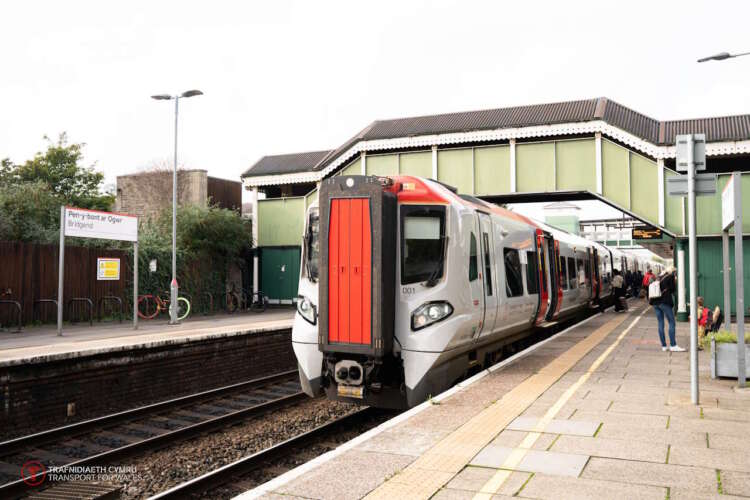Since the beginning of 2024, statistics show that there has been an improvement in performance by Transport for Wales train services.
The figures show that since January 2024, over 80% of Transport for Wales trains arrived on time or within 3 minutes of their scheduled arrival time.
The latest figures for March show that the performance has improved further, with 85% of train services arriving on time or within 3 minutes of their scheduled arrival time.

Service cancellations for all Transport for Wales services last year were below the annual average target of 5%.
A major contributory factor in the improvements in rail performance across the Wales and Borders network has been an £800 million investment Transport for Wales is making into brand-new trains.
The company expects that as more of these new trains are added to the fleet, performance will continue to improve through increased resilience and reliability.

[ruby_related heading=”Other news” total=3 layout=1]
Rail targets used to be measured in terms of Public Performance Measures that gave misleading figures as it was acceptable for a train to be late for most of a journey, but performance measures showed it arrived on time at its last scheduled stop.
This was often achieved by missing out on some scheduled station stops to ‘catch up’ with the timetable.
Performance is now measured by three essential metrics: Passenger Time Lost, Cancellations, and Short Formations, which respectively focus on punctuality, reliability, and capacity.
- Passenger Time Lost is a new metric that measures punctuality to within 3 minutes at every station stop on a journey and takes account of the number of passengers arriving at their destination.
- Cancellations measure the reliability of a service.
- Short Formations measure the percentage of services formed with fewer carriages than scheduled.

Included in the current statistics are Service Provision which includes Passenger Time Lost, Short Formations, and On-the-Day Cancellations; Effectiveness in terms of Passenger km, Passenger and Farebox Revenue, Total Passengers Carried; Customer Satisfaction; and Cost Efficiency in terms of Cost per Passenger km, Cost per Passengers CarriedNOx Emissions per Passenger km, and CO2 Emissions per Passenger km.
The latest figures show a welcome improvement since last August when Transport Focus challenged Transport for Wales to improve its rail services.
They have also been helped by the introduction of South Wales’ new Metro trains.
A full breakdown of the performance statistics for Transport for Wales is available online at https://tfw.wales/about-us/transparency/performance.
Our rail performance figures for 2024 are encouraging and have shown an improvement of how our trains are operating on our network and we’re hitting our targets.
Nearly fifty percent of our train fleet has been replaced with newer trains as part of our transformation programme and as we continue to add more brand-new trains to our network we expect to see continued improvements.
Adam Terry, Transport for Wales Head of Rail Performance






Responses
Recently used the Wales Explorer pass, and it was mostly decent and on time, with the exception of Chepstow to Newport which was hit by delays and cancellations. And the entire Conway valley line was closed on a lovely Saturday as there were no trains available. And no replacement bus service advertised.
Other than that the rest of the rural trains, while new, where crowded to the point of wondering if they were short-formed.
TfW are certainly not improving from my personal perspective and to top it off their schedule sees fewer and fewer services. Take the Crewe to Chester shuttle, this is now wholly inadequate and with TfW timetabling iu can find yourself sitting in the decrepit Crewe station for just short of an hour for the link up to the north Wales coast route.
They may be improving on paper but fewer services makes that a bit easier. If you want a train from Shotton to the wirral well…. Good luck with that one! There’s a chance it will run, a chance.
Summary, TfW does not seemingly run a service for all regions and all customers. It does however run a service for Cardiff and some of the valleys, some
Recent trip from Birmingham International to Rhyl. 4 coaches on Holyhead train reduced to 2 at Shrewsbury and absolutely jammed from there. Luggage in aisles stopping movement on train. This was with 158 train. New 197’s don’t have any luggage/ buggy space and fewer toilets so making travel more difficult. Obviously airport travel has been ignored in this design, although we do have the dubious pleasure of hard ironing board seats
Nearly as bad on Valleys lines. Never on time, cancelled, filthy standing room only carriages. South Wales Metro years ++++ late & 100s of millions over budget. I wud like to know why tfw use Welsh trains between english towns & cities, well àway from Wales.
Try telling that to people who live near the Heart of Wales line where cancellations, breakdowns and late running are an everyday experience.
Take Sunday afternoon (May 26th): 2M39 the 15:37 from Swansea to Shrewsbury ran as far as Llanwrtyd waited 50 minutes and turned back. 2V08 the 16:20 from Shrewsbury to Cardiff Central ran only to Llandrindod, waited 10 minutes then departed back to Shrewsbury. Both trains were roughly on time and the reason given for cancellation was “an issue with the crew”.
TfW’s JourneyCheck web site was as hopelessly inaccurate as ever listing the trains as both cancelled and being additional trains at the same time – six entries to be precise – to confuse Joe Public.
And what happened to the passengers? Who knows how anyone got from Llandrindod to Llanwrtyd or vice versa on a Sunday evening when public transport is at its minimum in rural Wales. There’s no evidence that TfW even made an attempt to provide a bus replacement service – something else that is becoming more common.
How does this – a typical scenario – tie up with an improved service?